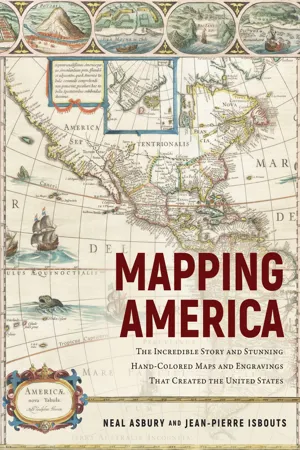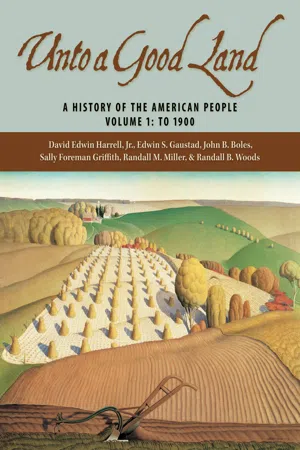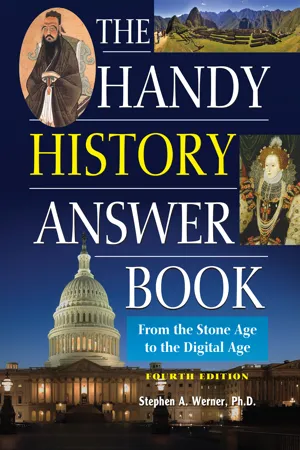History
The Thirteen Colonies
The Thirteen Colonies were a group of British colonies on the Atlantic coast of North America, established in the 17th and 18th centuries. They were divided into three regions: New England, the Middle Colonies, and the Southern Colonies. The colonies played a significant role in the history of the United States, ultimately leading to the American Revolution and the formation of the nation.
Written by Perlego with AI-assistance
Related key terms
Related key terms
1 of 4
Related key terms
1 of 3
3 Key excerpts on "The Thirteen Colonies"
- eBook - ePub
Mapping America
The Incredible Story and Stunning Hand-Colored Maps and Engravings that Created the United States
- Jean-Pierre Isbouts, Neal Asbury(Authors)
- 2021(Publication Date)
- Apollo Publishers(Publisher)
By the beginning of the eighteenth century, the English colonies of North America were shifting from living as isolated communities to becoming a true melting pot of a whole host of Europeans: English Quakers and Puritans who settled in New England; Swedes and Finns who built their farms along the Delaware River; English and French Catholics who settled in Maryland; Germans who colonized the mid-Atlantic regions; and Ulster Scots who headed for the Appalachian Mountains. Eventually, all these territories would become known as “The Thirteen Colonies”—a remarkable achievement, certainly given the mostly fruitless efforts of the French, the Spanish, and the Dutch to accomplish something similar on North American soil. Other than two brief revolts—Leisler’s Rebellion in New York and Bacon’s Rebellion in Virginia, both in the last quarter of the seventeenth century—the relations between these highly diverse European communities were surprisingly peaceful, certainly considering that back on the European continent, many of their home countries were at war for one reason or another.Eventually, these colonies coalesced into four main territories, including New England (comprising today’s Massachusetts, Connecticut, New Hampshire, and Rhode Island); the Middle Colonies (present-day New York, New Jersey, Pennsylvania, and Delaware); the Chesapeake Bay Colonies (including Virginia and Maryland); and the Southern Colonies (including the Carolinas and Georgia), which after 1763 also included Florida.As these communities grew, the English Crown realized that their supervision could no longer be entrusted to the various commercial companies that had fostered colonization to begin with. In 1625 , the government set up the Board of Trade, tasked with addressing any issues or problems that affected the colonials in America.Fig. 70. Robert Morden et al., Map of the English Empire in North America , 1685. This is perhaps the finest map of England’s American colonies at the close of the seventeenth century, from the Hudson to the Chesapeake Bay.As the name “Board of Trade” suggests, the primary purpose of the English colonies was to foster trade between themselves and the home country. Since no one had found any meaningful sources of gold and silver, as in the Spanish and Portuguese territories down south, it was clear that the whole point of American colonization was to encourage an ever-growing mercantile exchange between American colonists and English merchants back home. This was done by deploying an elaborate system of trade regulations, barriers, and subsidies guaranteed to maximize profits for the English Crown (in the form of trade duties) and to discourage trade with anyone else. What it also meant, however, was that the colonies became a captive market for English industry and that every attempt was made to dissuade the Americans from doing business with any of England’s rivals. - eBook - ePub
Unto a Good Land
A History of the American People, Volume 1: To 1900
- David Edwin Harrell, Edwin S. Gaustad, John B. Boles, Sally Foreman Griffith(Authors)
- 2005(Publication Date)
- Eerdmans(Publisher)
5
Self-Governing Colonies in a Changing Empire, 1700-1775
Chapter 5 at a Glance The Practice of Colonial Politics Politics at Home Politics Abroad The Contest for a Continent Spain: Safeguarding an Empire France: Winning an Empire Political Thought and Political Passion in British North America The Great War for Empire An Aggressive Kingdom A Roused People Religious Imperialism Colonists Convene a Congress Conclusion: Battles for ControlA S BRITISH NORTH Americans were coming into social and cultural maturity in the mid-eighteenth century, they were simultaneously struggling to achieve political maturity. Sometimes those struggles went on within the individual colony; at other times colonial politicians contested the policies of the British Empire. Most often those policies took the form of periodic attempts to make the colonies more profitable to the mother country and to protect economic interests in Britain. But political authorities were rarely united. Parliament, more interested in asserting its authority over the king, passed more and more legislation — more than eighty acts in the first half of the eighteenth century — aimed at tightening control over colonial trade and such other aspects of colonial life as the sale of lands and the naturalization of foreigners. But if Parliament was more active, it was only rarely more effective. On the other hand, the royally appointed Board of Trade had to take a second place in colonial matters, even though its knowledge of the actual circumstances in the “foreign plantations” generally exceeded that of members of Parliament. And Parliament, ever vigilant in passing its laws, proved less vigorous in ensuring their enforcement.In 1711, Parliament passed the first of three White Pine acts designed to preserve the forests of North America to meet the navy’s incessant demand for masts, spars, and other ship timbers. Having denuded its own forests over the centuries, Great Britain now needed other sources of supply. North America surely constituted such a source — but it had to be preserved for imperial use. The provisions of these acts were so sweeping that they invited, if not demanded, evasion by the colonists. The Hat and Felt Act, approved in 1732, tried to limit competing colonial industry by restricting the sale of any hats made by colonists to the colony that produced them. The next year, 1733, saw the appearance of the Sugar Act (or Molasses Act) designed specifically to curb the growing colonial trade with the French Caribbean islands. Not only did Britain suffer from this trade, but France prospered — a doubly intolerable situation. By imposing a heavy tax on every gallon of foreign molasses, Parliament could theoretically stop this trade with the French. Again, however, enforcement was lax. Similarly, the Iron Act of 1750 and the Currency Act of 1751 were drawn up to serve British, not colonial, interests. In the end, they did more to irritate the colonists than to profit the mother country. - eBook - ePub
The Handy History Answer Book
From the Stone Age to the Digital Age
- Stephen A. Werner(Author)
- 2020(Publication Date)
- Visible Ink Press(Publisher)
The British would establish colonies along the Eastern Seaboard from Georgia in the South to Massachusetts in the North, which included the land that would eventually become Maine. Since most of the immigrants from Britain were Protestants, most of the colonies were Protestant. For example, the Anglican Church was the official religion in Virginia. Maryland, an exception, was established as a Catholic colony. However, Protestants eventually took control and took away the religious freedom of Catholics. The colony of Pennsylvania was set up by a Quaker, William Penn.What were the original thirteen British colonies? Here are The Thirteen Colonies listed chronologically from when they were established:
What was the French and Indian War?Original Thirteen Colonies Colony Year Established Virginia 1607 New York 1626 Massachusetts Bay (included Maine) 1630 Maryland 1633 Rhode Island 1636 Connecticut 1636 New Hampshire 1638 Delaware 1638 North Carolina 1653 South Carolina 1663 New Jersey 1664 Pennsylvania 1682 Georgia 1732 The French and Indian War (1754–1763) was the last major conflict in North America before the Revolutionary War. For decades, Britain and France had steadily expanded their territories into the Ohio River valley. Since the fur trade prospered in this region, both countries wished to control it. As the French encroached on their territory, the British governor sent an ultimatum to them, delivered by none other than George Washington (1732–1799). But the French did not intend to back down. In 1754, Washington (now a lieutenant colonel) and 150 troops established a British outpost at present-day Pittsburgh, not far from the French Fort Duquesne. That spring and summer, fighting broke out.Washington met the French, and though he and his troops mustered a strong resistance, there were early losses for the British. But a reinvigorated British force, under the leadership of Britain’s secretary of state, William Pitt (1759–1806), took French forts along the Allegheny River in western Pennsylvania and met French troops in battle at Quebec. In 1755, Washington was made colonel and led the Virginia troops in defending the frontier from French and Indian attacks. Though the British finally succeeded in occupying Fort Duquesne in 1758, fighting continued until 1763, when the Treaty of Paris ended the war.
Index pages curate the most relevant extracts from our library of academic textbooks. They’ve been created using an in-house natural language model (NLM), each adding context and meaning to key research topics.
Explore more topic indexes
Explore more topic indexes
1 of 6
Explore more topic indexes
1 of 4


